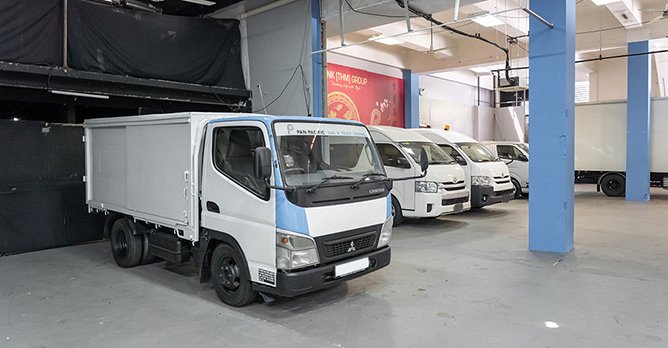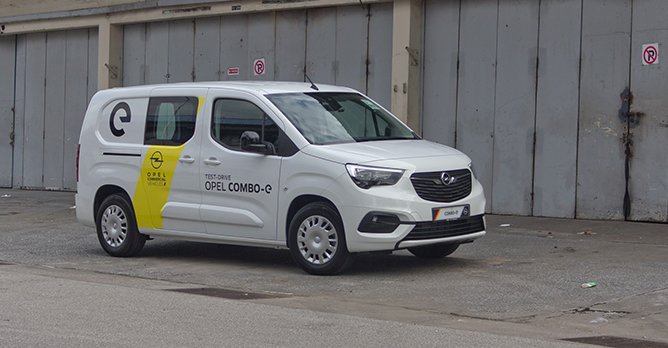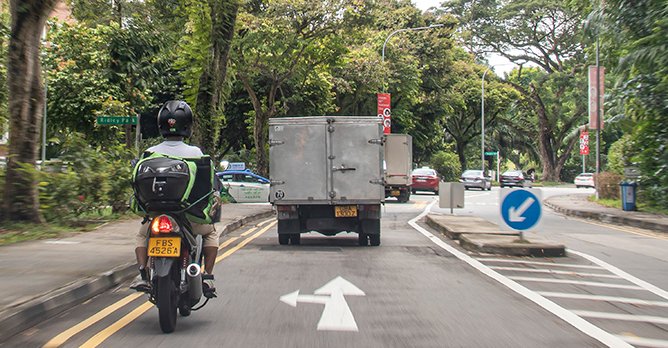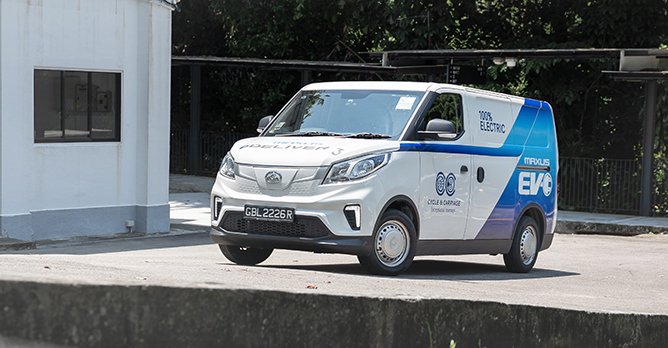The future of commercial vehicles: Why aren't we talking about it more?
23 Feb 2023|6,333 views
There's so much conversation about electrification and electric cars today. It's the new, sexy thing (just look at Tesla), but equally as clear is the impetus for brands to have to pursue a more carbon neutral future.
Singapore, similarly, has such plans in place, though as we've previously explored, it's perhaps less clear and precise than some would imagine.
Yet with all the conversation around electric cars, there's a whole other category of vehicles that don't seem to be talked about as much - commercial vehicles (CVs), otherwise classified by LTA as 'Goods & Other Vehicles'.
Why we need to look at commercial vehicles
It's important to note that one key tenet of the Singapore Green Plan 2030 is for 'new registrations of diesel cars and taxis to cease from 2025'. And even with the 2030 target of 'cleaner-energy models', that also appears to apply only to cars and taxis.
What then, of CVs? After all, CVs are the second largest vehicle population in Singapore after passenger cars (and slightly more than motorcycles in third place). However, there presently does not seem to be any concrete direction or deadline when it comes to CVs, beyond the current Early Turnover Scheme (a little more on that later).
Looking at LTA stats over the past 11 years, 'MOTOR VEHICLE POPULATION BY TYPE OF FUEL USED', a few trends stand out.
Diesel car registrations are actually up notably in the past few years, with the diesel car population at an all-time high. The overall diesel CV population has fallen, but the difference is chiefly made up by petrol models, and just slightly with electric models. And, unsurprisingly, buses and CVs are still overwhelmingly diesel.
Electric CVs? While there has been solid growth, it still makes up a tiny fraction of the overall CV population (just 1.3%).
A closer look
Taking a closer look at CVs, it's worth pointing out that while the overall population dipped in 2019 & 2020, as of 2022 it's basically as high as in the past decade (almost 145k). What this tells us is that the overall CV population has held pretty steady over the past 11 years. This is similar to buses and motorbikes, whereas passenger cars have increased, and taxis in 2022 are half the number compared to 2012.
The steady CV population should not be surprising. After all, these vehicles serve specific roles within our overall economy, a large number likely being goods transport.
That said, diesel CVs overwhelmingly make up not just the CV population, but also most of the diesel vehicle population in Singapore. And, of the 995,746 total motor vehicles on Singapore roads, the 131,623 diesel CVs make up 13.2% - the third largest single fuel-type population behind petrol cars and petrol motorcycles (just a fraction fewer than basically all bikes on our roads).
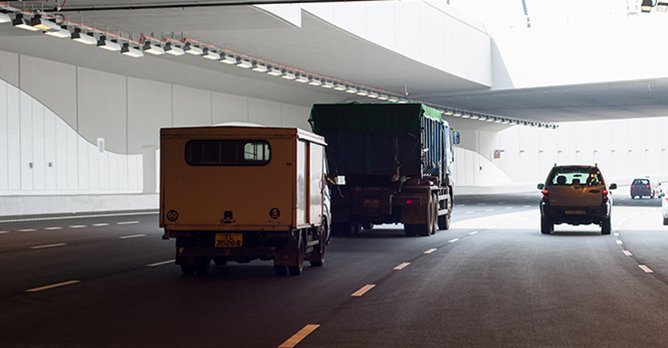
 Considering goods vehicle cover twice as much mileage as the average passenger car, the greater carbon impact is obvious Why this focus on diesel CVs? Because when it comes to reducing overall carbon emissions and moving towards a 'greener' society, it would follow that cleaner CVs would go a significant way towards that. According to the LTA, goods vehicles cover an average of 'about 40,000km which is more than twice the average annual mileage of 19,000km for cars'. The carbon impact is thus obviously higher.
Considering goods vehicle cover twice as much mileage as the average passenger car, the greater carbon impact is obvious Why this focus on diesel CVs? Because when it comes to reducing overall carbon emissions and moving towards a 'greener' society, it would follow that cleaner CVs would go a significant way towards that. According to the LTA, goods vehicles cover an average of 'about 40,000km which is more than twice the average annual mileage of 19,000km for cars'. The carbon impact is thus obviously higher.
This is why we have the ETS, first effected in 2013 to encourage commercial vehicles owners to adopt cleaner models. Has it worked? That's a difficult question to answer (also because there's not much data available publicly).
There are, of course, two scenarios in play. The first is the turnover of older diesel models to newer, cleaner diesel models. The second, perhaps more difficult but arguably more necessary scenario, is replacing diesel models with petrol or electric ones.
The second scenario is much, much less likely. The diesel population has only started to see a realistic fall starting from 2019, and even so by a relatively small percentage. - even if we use the most optimistic of projections of 2,904 fewer vehicles a year (the drop from '21 to '22), it will still take an eternity to completely phase out diesel CVs on our roads (46 years, according to my rudimentary MS Excel skills).
What is clearly needed is some additional way to accelerate the transition from diesels to cleaner energy models, whether it's petrol, petrol-electric or fully electric.
It’s also worth noting that of the 144,984 CVs on our roads today, the most significant bulk of them are between 3-9 years old, which means these vehicles will likely be on our roads for the foreseeable future.
Diesel is likely here to stay
There appears to be no clear direction from LTA with regards to what will happen to commercial vehicles. The ETS has been extended once more to 2025. What happens next?
There are certainly going to be a range of revisions ahead. As stated in a Nov 2022 NEA press release, "The Government will be studying other means, including regulatory levers, to encourage the early turnover of older commercial vehicles and buses in the future."
However, looking at the sheer numbers alone, it's fair to assume that diesel vehicles, in quite significant numbers, are likely here to stay for the foreseeable future (newly registered CVs have a 20-year life span). It's incredibly unlikely that we'll see the same no-diesel timeline as with passenger cars and taxis.
Yes, there's plenty of bitching and moaning about cars, but we shouldn't lose sight of the fact that commercial vehicles play a critical role in our economy - driving not just a lot of individual consumer functions (delivery and the likes), but of course plenty of commercial ones as well.
There is some hope, though. Across all motor vehicles excluding motorcycles, commercial vehicles saw the greatest single year growth in electric population (469% increase from 2021). It also helps that there are more electric CVs now available in the market - new models like the Opel Combo-e and Maxus e Deliver 3 mean that businesses have more choices and options when it comes to fleshing out their fleets.
For our collective sake, let's hope that that trend continues.
Singapore, similarly, has such plans in place, though as we've previously explored, it's perhaps less clear and precise than some would imagine.
Yet with all the conversation around electric cars, there's a whole other category of vehicles that don't seem to be talked about as much - commercial vehicles (CVs), otherwise classified by LTA as 'Goods & Other Vehicles'.
Why we need to look at commercial vehicles
It's important to note that one key tenet of the Singapore Green Plan 2030 is for 'new registrations of diesel cars and taxis to cease from 2025'. And even with the 2030 target of 'cleaner-energy models', that also appears to apply only to cars and taxis.
What then, of CVs? After all, CVs are the second largest vehicle population in Singapore after passenger cars (and slightly more than motorcycles in third place). However, there presently does not seem to be any concrete direction or deadline when it comes to CVs, beyond the current Early Turnover Scheme (a little more on that later).
Looking at LTA stats over the past 11 years, 'MOTOR VEHICLE POPULATION BY TYPE OF FUEL USED', a few trends stand out.
Diesel car registrations are actually up notably in the past few years, with the diesel car population at an all-time high. The overall diesel CV population has fallen, but the difference is chiefly made up by petrol models, and just slightly with electric models. And, unsurprisingly, buses and CVs are still overwhelmingly diesel.
Electric CVs? While there has been solid growth, it still makes up a tiny fraction of the overall CV population (just 1.3%).
A closer look
Taking a closer look at CVs, it's worth pointing out that while the overall population dipped in 2019 & 2020, as of 2022 it's basically as high as in the past decade (almost 145k). What this tells us is that the overall CV population has held pretty steady over the past 11 years. This is similar to buses and motorbikes, whereas passenger cars have increased, and taxis in 2022 are half the number compared to 2012.
The steady CV population should not be surprising. After all, these vehicles serve specific roles within our overall economy, a large number likely being goods transport.
That said, diesel CVs overwhelmingly make up not just the CV population, but also most of the diesel vehicle population in Singapore. And, of the 995,746 total motor vehicles on Singapore roads, the 131,623 diesel CVs make up 13.2% - the third largest single fuel-type population behind petrol cars and petrol motorcycles (just a fraction fewer than basically all bikes on our roads).

This is why we have the ETS, first effected in 2013 to encourage commercial vehicles owners to adopt cleaner models. Has it worked? That's a difficult question to answer (also because there's not much data available publicly).
There are, of course, two scenarios in play. The first is the turnover of older diesel models to newer, cleaner diesel models. The second, perhaps more difficult but arguably more necessary scenario, is replacing diesel models with petrol or electric ones.
The second scenario is much, much less likely. The diesel population has only started to see a realistic fall starting from 2019, and even so by a relatively small percentage. - even if we use the most optimistic of projections of 2,904 fewer vehicles a year (the drop from '21 to '22), it will still take an eternity to completely phase out diesel CVs on our roads (46 years, according to my rudimentary MS Excel skills).
What is clearly needed is some additional way to accelerate the transition from diesels to cleaner energy models, whether it's petrol, petrol-electric or fully electric.
It’s also worth noting that of the 144,984 CVs on our roads today, the most significant bulk of them are between 3-9 years old, which means these vehicles will likely be on our roads for the foreseeable future.
Diesel is likely here to stay
There appears to be no clear direction from LTA with regards to what will happen to commercial vehicles. The ETS has been extended once more to 2025. What happens next?
There are certainly going to be a range of revisions ahead. As stated in a Nov 2022 NEA press release, "The Government will be studying other means, including regulatory levers, to encourage the early turnover of older commercial vehicles and buses in the future."
However, looking at the sheer numbers alone, it's fair to assume that diesel vehicles, in quite significant numbers, are likely here to stay for the foreseeable future (newly registered CVs have a 20-year life span). It's incredibly unlikely that we'll see the same no-diesel timeline as with passenger cars and taxis.
Yes, there's plenty of bitching and moaning about cars, but we shouldn't lose sight of the fact that commercial vehicles play a critical role in our economy - driving not just a lot of individual consumer functions (delivery and the likes), but of course plenty of commercial ones as well.
There is some hope, though. Across all motor vehicles excluding motorcycles, commercial vehicles saw the greatest single year growth in electric population (469% increase from 2021). It also helps that there are more electric CVs now available in the market - new models like the Opel Combo-e and Maxus e Deliver 3 mean that businesses have more choices and options when it comes to fleshing out their fleets.
For our collective sake, let's hope that that trend continues.
There's so much conversation about electrification and electric cars today. It's the new, sexy thing (just look at Tesla), but equally as clear is the impetus for brands to have to pursue a more carbon neutral future.
Singapore, similarly, has such plans in place, though as we've previously explored, it's perhaps less clear and precise than some would imagine.
Yet with all the conversation around electric cars, there's a whole other category of vehicles that don't seem to be talked about as much - commercial vehicles (CVs), otherwise classified by LTA as 'Goods & Other Vehicles'.
Why we need to look at commercial vehicles
It's important to note that one key tenet of the Singapore Green Plan 2030 is for 'new registrations of diesel cars and taxis to cease from 2025'. And even with the 2030 target of 'cleaner-energy models', that also appears to apply only to cars and taxis.
What then, of CVs? After all, CVs are the second largest vehicle population in Singapore after passenger cars (and slightly more than motorcycles in third place). However, there presently does not seem to be any concrete direction or deadline when it comes to CVs, beyond the current Early Turnover Scheme (a little more on that later).
Looking at LTA stats over the past 11 years, 'MOTOR VEHICLE POPULATION BY TYPE OF FUEL USED', a few trends stand out.
Diesel car registrations are actually up notably in the past few years, with the diesel car population at an all-time high. The overall diesel CV population has fallen, but the difference is chiefly made up by petrol models, and just slightly with electric models. And, unsurprisingly, buses and CVs are still overwhelmingly diesel.
Electric CVs? While there has been solid growth, it still makes up a tiny fraction of the overall CV population (just 1.3%).
A closer look
Taking a closer look at CVs, it's worth pointing out that while the overall population dipped in 2019 & 2020, as of 2022 it's basically as high as in the past decade (almost 145k). What this tells us is that the overall CV population has held pretty steady over the past 11 years. This is similar to buses and motorbikes, whereas passenger cars have increased, and taxis in 2022 are half the number compared to 2012.
The steady CV population should not be surprising. After all, these vehicles serve specific roles within our overall economy, a large number likely being goods transport.
That said, diesel CVs overwhelmingly make up not just the CV population, but also most of the diesel vehicle population in Singapore. And, of the 995,746 total motor vehicles on Singapore roads, the 131,623 diesel CVs make up 13.2% - the third largest single fuel-type population behind petrol cars and petrol motorcycles (just a fraction fewer than basically all bikes on our roads).

 Considering goods vehicle cover twice as much mileage as the average passenger car, the greater carbon impact is obvious Why this focus on diesel CVs? Because when it comes to reducing overall carbon emissions and moving towards a 'greener' society, it would follow that cleaner CVs would go a significant way towards that. According to the LTA, goods vehicles cover an average of 'about 40,000km which is more than twice the average annual mileage of 19,000km for cars'. The carbon impact is thus obviously higher.
Considering goods vehicle cover twice as much mileage as the average passenger car, the greater carbon impact is obvious Why this focus on diesel CVs? Because when it comes to reducing overall carbon emissions and moving towards a 'greener' society, it would follow that cleaner CVs would go a significant way towards that. According to the LTA, goods vehicles cover an average of 'about 40,000km which is more than twice the average annual mileage of 19,000km for cars'. The carbon impact is thus obviously higher.
This is why we have the ETS, first effected in 2013 to encourage commercial vehicles owners to adopt cleaner models. Has it worked? That's a difficult question to answer (also because there's not much data available publicly).
There are, of course, two scenarios in play. The first is the turnover of older diesel models to newer, cleaner diesel models. The second, perhaps more difficult but arguably more necessary scenario, is replacing diesel models with petrol or electric ones.
The second scenario is much, much less likely. The diesel population has only started to see a realistic fall starting from 2019, and even so by a relatively small percentage. - even if we use the most optimistic of projections of 2,904 fewer vehicles a year (the drop from '21 to '22), it will still take an eternity to completely phase out diesel CVs on our roads (46 years, according to my rudimentary MS Excel skills).
What is clearly needed is some additional way to accelerate the transition from diesels to cleaner energy models, whether it's petrol, petrol-electric or fully electric.
It’s also worth noting that of the 144,984 CVs on our roads today, the most significant bulk of them are between 3-9 years old, which means these vehicles will likely be on our roads for the foreseeable future.
Diesel is likely here to stay
There appears to be no clear direction from LTA with regards to what will happen to commercial vehicles. The ETS has been extended once more to 2025. What happens next?
There are certainly going to be a range of revisions ahead. As stated in a Nov 2022 NEA press release, "The Government will be studying other means, including regulatory levers, to encourage the early turnover of older commercial vehicles and buses in the future."
However, looking at the sheer numbers alone, it's fair to assume that diesel vehicles, in quite significant numbers, are likely here to stay for the foreseeable future (newly registered CVs have a 20-year life span). It's incredibly unlikely that we'll see the same no-diesel timeline as with passenger cars and taxis.
Yes, there's plenty of bitching and moaning about cars, but we shouldn't lose sight of the fact that commercial vehicles play a critical role in our economy - driving not just a lot of individual consumer functions (delivery and the likes), but of course plenty of commercial ones as well.
There is some hope, though. Across all motor vehicles excluding motorcycles, commercial vehicles saw the greatest single year growth in electric population (469% increase from 2021). It also helps that there are more electric CVs now available in the market - new models like the Opel Combo-e and Maxus e Deliver 3 mean that businesses have more choices and options when it comes to fleshing out their fleets.
For our collective sake, let's hope that that trend continues.
Singapore, similarly, has such plans in place, though as we've previously explored, it's perhaps less clear and precise than some would imagine.
Yet with all the conversation around electric cars, there's a whole other category of vehicles that don't seem to be talked about as much - commercial vehicles (CVs), otherwise classified by LTA as 'Goods & Other Vehicles'.
Why we need to look at commercial vehicles
It's important to note that one key tenet of the Singapore Green Plan 2030 is for 'new registrations of diesel cars and taxis to cease from 2025'. And even with the 2030 target of 'cleaner-energy models', that also appears to apply only to cars and taxis.
What then, of CVs? After all, CVs are the second largest vehicle population in Singapore after passenger cars (and slightly more than motorcycles in third place). However, there presently does not seem to be any concrete direction or deadline when it comes to CVs, beyond the current Early Turnover Scheme (a little more on that later).
Looking at LTA stats over the past 11 years, 'MOTOR VEHICLE POPULATION BY TYPE OF FUEL USED', a few trends stand out.
Diesel car registrations are actually up notably in the past few years, with the diesel car population at an all-time high. The overall diesel CV population has fallen, but the difference is chiefly made up by petrol models, and just slightly with electric models. And, unsurprisingly, buses and CVs are still overwhelmingly diesel.
Electric CVs? While there has been solid growth, it still makes up a tiny fraction of the overall CV population (just 1.3%).
A closer look
Taking a closer look at CVs, it's worth pointing out that while the overall population dipped in 2019 & 2020, as of 2022 it's basically as high as in the past decade (almost 145k). What this tells us is that the overall CV population has held pretty steady over the past 11 years. This is similar to buses and motorbikes, whereas passenger cars have increased, and taxis in 2022 are half the number compared to 2012.
The steady CV population should not be surprising. After all, these vehicles serve specific roles within our overall economy, a large number likely being goods transport.
That said, diesel CVs overwhelmingly make up not just the CV population, but also most of the diesel vehicle population in Singapore. And, of the 995,746 total motor vehicles on Singapore roads, the 131,623 diesel CVs make up 13.2% - the third largest single fuel-type population behind petrol cars and petrol motorcycles (just a fraction fewer than basically all bikes on our roads).

This is why we have the ETS, first effected in 2013 to encourage commercial vehicles owners to adopt cleaner models. Has it worked? That's a difficult question to answer (also because there's not much data available publicly).
There are, of course, two scenarios in play. The first is the turnover of older diesel models to newer, cleaner diesel models. The second, perhaps more difficult but arguably more necessary scenario, is replacing diesel models with petrol or electric ones.
The second scenario is much, much less likely. The diesel population has only started to see a realistic fall starting from 2019, and even so by a relatively small percentage. - even if we use the most optimistic of projections of 2,904 fewer vehicles a year (the drop from '21 to '22), it will still take an eternity to completely phase out diesel CVs on our roads (46 years, according to my rudimentary MS Excel skills).
What is clearly needed is some additional way to accelerate the transition from diesels to cleaner energy models, whether it's petrol, petrol-electric or fully electric.
It’s also worth noting that of the 144,984 CVs on our roads today, the most significant bulk of them are between 3-9 years old, which means these vehicles will likely be on our roads for the foreseeable future.
Diesel is likely here to stay
There appears to be no clear direction from LTA with regards to what will happen to commercial vehicles. The ETS has been extended once more to 2025. What happens next?
There are certainly going to be a range of revisions ahead. As stated in a Nov 2022 NEA press release, "The Government will be studying other means, including regulatory levers, to encourage the early turnover of older commercial vehicles and buses in the future."
However, looking at the sheer numbers alone, it's fair to assume that diesel vehicles, in quite significant numbers, are likely here to stay for the foreseeable future (newly registered CVs have a 20-year life span). It's incredibly unlikely that we'll see the same no-diesel timeline as with passenger cars and taxis.
Yes, there's plenty of bitching and moaning about cars, but we shouldn't lose sight of the fact that commercial vehicles play a critical role in our economy - driving not just a lot of individual consumer functions (delivery and the likes), but of course plenty of commercial ones as well.
There is some hope, though. Across all motor vehicles excluding motorcycles, commercial vehicles saw the greatest single year growth in electric population (469% increase from 2021). It also helps that there are more electric CVs now available in the market - new models like the Opel Combo-e and Maxus e Deliver 3 mean that businesses have more choices and options when it comes to fleshing out their fleets.
For our collective sake, let's hope that that trend continues.
Thank You For Your Subscription.












